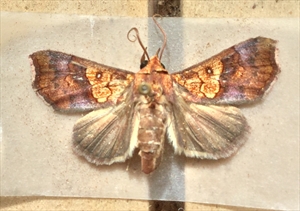Cotton semi-looper, okra caterpillar
Pacific Pests, Pathogens, Weeds & Pesticides - Online edition
Pacific Pests, Pathogens, Weeds & Pesticides
Cotton semi-looper (398)
Anomis flava; it was previously known as Cosmophila flava. It is a moth of the Erebidae.
Asia, Africa, North, South and Central America, Oceania. It is recorded from Australia, American Samoa, Cook Islands, Fiji, French Polynesia, Guam, New Caledonia, New Zealand, Northern Mariana Islands, Papua New Guinea, Samoa, Solomon Islands, Tonga, and Vanuatu.
Bele, cotton, okra, tomato, ornamentals, e.g., hibiscus, and weeds, e.g., Sida acuta, Urena species. Mostly members of the mallows or Malvaceae family.
The larva or caterpillar does the damage by eating large parts of the leaves. Occasionally, entire plants are defoliated.
Eggs are laid singly on leaves. They hatch to produce long, green larvae with seven rows of faint, white dots or broken bands along the body, and yellowish bands between the segments (Photo 1). There are four pairs of abdominal feet (prolegs) on segments 4,5, 6 and 10, and because of the missing prolegs the larva moves like a looper. Pupation occurs in folded leaves or amongst leaves on the soil. The adults have a wingspan of about 30 mm (males about 25 mm), and they are 12 mm long. The forewings are a mottled brown with patches of gold near the body; the hind wings are yellow-brown (Photo 2).
It was not thought to be damaging on bele in Fiji, and no recommendations were given by Swaine (1971)1. In India, it is said to be a serious pest of cotton in Gujarat and Rajasthan States, but only occasionally, and in some parts of the country. The mature larvae cause the most damage, eating leaves entirely, except for the main veins, as well as attacking shoots, buds and bolls (on cotton). Reports from Tamil Nadu say that epidemics occur in years of heavy rainfall.
Look for the distinctive long green larvae, with white lines or dots along the body and yellowish lines between segments. Look for the attractive adult with golden patches near the body on the forewings.
NATURAL ENEMIES
Studies in India and Brasil report tachinid flies and wasp parasitoids as natural enemies of Anomis flava. In India, there are also entomopathogenic fungi causing high mortality. In Orissa, several biorational pesticides (e.g., Bt, spinosad, neem) had no effect on wasp parasiotids. However, natural enemies are not reported from Pacific island countries, but are likely to be present causing similar effects.
CULTURAL CONTROL
Before planting:
- Avoid overlapping crops of bele, okra, cotton and tomato).
- Avoid planting new crops next to old where Anomis flava larvae are present.
- Leave at least 3 month between crops.
During growth:
- Visit the crop frequently and regularly: twice a week is recommended, to check if there are caterpillars attacking the leaves, buds (and bolls of cotton). If found, do the following:
- Check the young leaves, and those where only the veins are left. Look for faeces on the leaves. They are the signs that caterpillars are present.
- Hand remove the larvae if only a few are present, and the area of the planting is small; if the area is large or if the infestation of larvae is high, consider using a pesticide. But consider carefully which ones to use.
- Provide adequate nutrients, by applying synthetic or organic fertilizers. Vigorously growing plants are better able to compensate for flower and pod damage, and damaged leaves are replaced more quickly.
After harvest:
- Collect and burn or bury as much of the crop as possible.
CHEMICAL CONTROL
- Use plant-derived products, such as neem, derris, pyrethrum and chilli (with the addition of soap), or commercial products that contain disease-causing organisms, such as spinosad (Success) and Bt - Bacillus thuringiensis subspecies kurstaki. Bt is best against young larvae.
- Note, Derris, brought many years ago to Solomon islands from Papua New Guinea, is effective as a spray. It contains rotenone, an insecticide, so it should be used with caution. There may be varieties of Derris (fish poisons) in your country that can be tried (see Fact Sheet no. 56).
- Synthetic pyrethroids are likely to be effective, but will also kill natural enemies (although none have yet to be reported from Pacific island countries).
____________________
When using a pesticide, always wear protective clothing and follow the instructions on the product label, such as dosage, timing of application, and pre-harvest interval. Recommendations will vary with the crop and system of cultivation. Expert advice on the most appropriate pesticides to use should always be sought from local agricultural authorities.
AUTHORS Grahame Jackson & Mani Mua
1Information from Swaine G (1971) Agricultural Zoology in Fiji. Her Majesty's Stationery Office. London; and Arora R et al. Integrated pest management of cotton in Punjab, India. University of Minnesota. (https://ipmworld.umn.edu/arora); and from CABI (2018) Anomis flava (cotton semi-looper). Crop Protection Compendium. (https://www.cabi.org/cpc/datasheet/15498).
Produced with support from the Australian Centre for International Agricultural Research under project HORT/2016/18: Responding to emerging pest and disease threats to horticulture in the Pacific islands, implemented by the University of Queensland and the Pacific Community.





